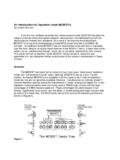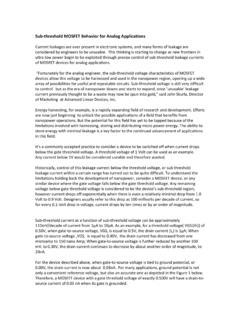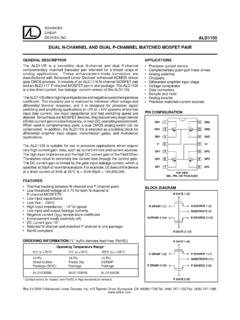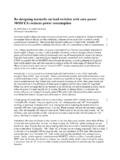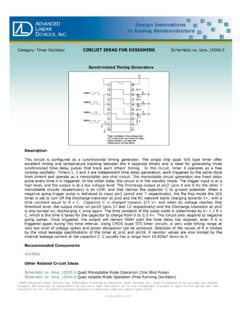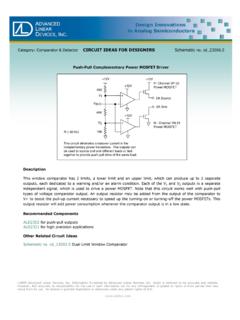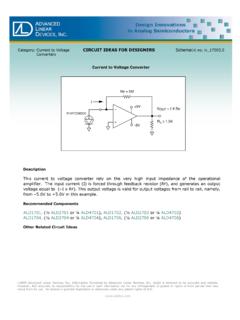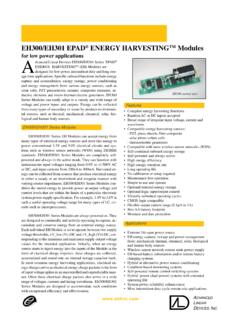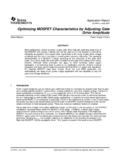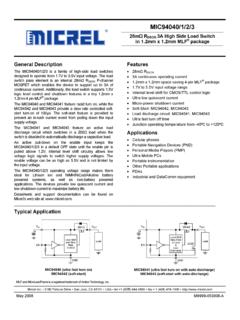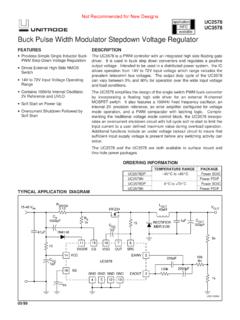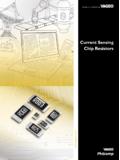Transcription of ALD8100XX/ALD9100XX FAMILY of …
1 2014 Advanced Linear Devices, Inc., Vers. of 17eEPADTM NABLEDEADVANCEDLINEARDEVICES, DESCRIPTIONThe ALD8100XX/ALD9100XX FAMILY of Supercapacitor auto Balanc-ing MOSFET Arrays, or SAB MOSFETs, are designed to addressvoltage and leakage current balancing of supercapacitors connectedin series. supercapacitors , also known as ultracapacitors orsupercaps, connected in series can be balanced with single ormultiple ALD8100XX/ALD9100XX packages. These SAB MOSFET sare built with ALD production proven EPAD MOSFET MOSFETs have unique electrical characteristics for superioractive continuous leakage current regulation and self-balancing ofstacked series-connected supercapacitors while dissipating nearzero leakage currents, practically eliminating extra power consump-tion.
2 For many applications, SAB MOSFET automatic charge bal-ancing offers a simple, economical and effective method to bal-ance and regulate supercapacitor voltages. With SAB MOSFETs,each supercapacitor in a series-connected stack is continuouslymonitored and automatically controlled for precise, effective bal-ancing of its voltage and leakage SAB MOSFET regulates the voltage across a supercapacitorcell by increasing its drain current exponentially across thesupercapacitor when its voltage increases, and by decreasing itsdrain current exponentially across the supercapacitor when its volt-age decreases. When a supercapacitor cell is charged to a volt-age less than 90% of the desired voltage limit, the SAB MOSFET across the supercap is turned off and there is zero leakage currentcontribution from the SAB MOSFET.
3 On the other hand, when thevoltage across the supercapacitor is over the desired voltage limit,the SAB MOSFET is turned on to increase its drain currents tokeep the supercapacitor voltage from rising. Simultaneously, thevoltages and leakages of other supercapacitors in the series stackare lowered to result in a near zero net increase in leakage ALD8100XX/ALD9100XX SAB MOSFET FAMILY offers a selec-tion of different threshold devices for various supercapacitor maxi-mum operating voltage values and desired leakage balancing char-acteristics as well as different temperature range environments. Alist of the available ALD part numbers can be found in the tables onpages 6 and 7 of this document. For individual datasheets andspecifications, please visit under SAB MOSFET.
4 SUPERCAPACITORSS upercapacitors are typically rated with a nominal recommendedworking voltage established for long life at their maximum ratedoperating temperature. When a supercapacitor cell voltage ex-ceeds its rated voltage for a prolonged time period, it experiencesreduced lifetime and eventual rupture and catastrophic failure. Toprevent such an occurrence, in most applications having two ormore supercapacitors connected in series, a means of automati-cally monitoring and adjusting charge-balancing at their maximumoperating voltages is required. This is due to different internal leak-age currents in each specific supercapacitor s leakage current is a variable function of manyparameters such as aging, initial leakage current at zero input volt-age, material and construction of the supercapactor, its chemistrycomposition, its leakage as a function of the charging voltage andthe charging current and temperature, operating temperature range,and the rate of change of many of these parameters.
5 Supercapacitorbalancing must correct for these changing effects automatically,with minimal added leakage currents or power FAMILY of SUPERCAPACITORAUTO BALANCING (SAB ) MOSFET ARRAYSSAB MOSFET ADVANTAGESThe ALD8100XX/ALD9100XX FAMILY of SAB MOSFETs are designedfor automatic supercapacitor balancing. They are replacements formany other passive or active supercapacitor balancing methodswhere cost, board space, efficiency, simplicity and power dissipa-tion are important design considerations. For example, in applica-tions where supercapacitors require minimum long-term power dis-sipation (internal leakage currents) as a primary goal, ALD8100XX/ALD9100XX SAB MOSFETs are simpler and more effective in per-forming the leakage balancing function, using significantly lessboard space and contributing no additional charge loss beyond thesupercapacitor s own leakages.
6 Other common methods of charge*IC pins are internally connected, connect to V-PIN CONFIGURATIONSSCL PACKAGESALD8100xxDN1GN1IC*DN4SN4GN4SN1V- 123456789 10 1112 13 1415 16 DN2GN2IC*DN3SN3GN3SN2V+V-V-M2M1M4M3V-V-S AL PACKAGESALD9100xxV-GN1DN1SN11234IC*GN2DN 2SN2, V-V+6785 ALD8100XX/ALD9100XX SUPERCAPACITORA dvanced Linear Devices, Inc. 2 of 17 auto BALANCING (SAB) MOSFET ARRAY FAMILY balancing generally contribute additional continuous power dissi-pation due to linear currents at all supercapacitor voltage levels,whereas SAB MOSFET leakages decrease exponentially with de-creased supercapacitor voltages. In many cases, the additionalleakage charge loss is near SUPERCAPACITOR auto BALANCINGUSING SAB MOSFETSThe principle behind the SAB MOSFET in balancingsupercapacitors is simple.
7 It is based on the natural threshold char-acteristics of a MOSFET device. The threshold voltage of aMOSFET is the voltage at which a MOSFET turns on and starts toconduct a current. The drain current of the MOSFET, at or belowits threshold voltage, is an exponential function of its gate , for small changes in the MOSFET s gate voltage, its drain-source on-current can vary greatly, by orders of magnitude. ALD sSAB MOSFETs are designed to take advantage of this fundamen-tal device MOSFETs are connected in the Vt mode, meaning that theGate-to-Source and the Drain-to-Source terminals of each MOSFETare always connected. In this mode VGS is always equal to VDSand when this joint terminal is connected across a supercapacitor,it is also referred to as an Input Voltage, VIN.
8 Each SAB MOSFEThas a well defined Drain-to-Source Current, IDS(ON), for differentvalues of VIN Voltages. This current is also referred to as the Out-put Current, IOUT, of the SAB MOSFETs can be connected in parallel or in series, to suit thedesired leakage current characteristics, in order to charge-balancean array of supercapacitors connected in series. The array of com-bined SAB MOSFETs and supercapacitors would be automaticallyself-regulating with various leakage mismatches and environmen-tal temperature changes. The SAB MOSFETs can also be usedentirely in the subthreshold mode, meaning the SAB MOSFET isused at min., nominal and max. operating voltages in voltage rangesbelow its specified threshold the ALD8100XX/ALD9100XX FAMILY , the threshold voltage Vtof an SAB MOSFET is defined as its drain-gate source voltage at adrain-source ON current, IDS(ON) = 1 A, when its gate and drainterminals are connected together (VGS = VDS).
9 This voltage isspecified as xx, where the threshold voltage is in examples are: the ALD810025 features a precise thresholdvoltage of Vt = at IDS(ON) = 1 A and the AL D810017 hasVt = at IDS(ON) = 1 all ALD8100XX/ALD9100XX devices operate similarly, with lin-ear voltage shifts, an ALD810025 is used as an illustration of itscharacteristics. At voltages below its threshold voltage, theALD810025 rapidly turns off at a rate of approximately one decadeof current per 104mV of voltage drop. Hence, at VIN = , theALD810025 IOUT is A. At VIN = , its IOUT A. When VIN drops further to , its IOUT A. It should be apparent that at VIN , the ALD810025 IOUT A, which is near zero when compared to 1 A atVIN = At VIN below , the SAB MOSFET Output Current,IOUT, goes to essentially zero (~70pA).
10 The IOUT A iscontrolled and repeatable for different units from various produc-tion exponential relationship between the SAB MOSFET s VIN andIOUT can be an important consideration in replacing certainsupercapacitor charge balancing applications currently using fixedresistors, operational amplifier circuits or other forms of charge bal-ancing. These other conventional charge-balancing methods con-tinue to dissipate a significant amount of current, even after thevoltage across the supercapacitors has dropped, because the cur-rent dissipated is a linear function, rather than an exponential func-tion, of the supercapacitor voltage (I = V/R). For supercapacitorseries stacks with more than two cells, the challenge of leakagebalancing becomes even more most other passive or active circuits that offer charge balanc-ing, active power is still being consumed even if the supercapacitorvoltage falls much below its operating voltage.
